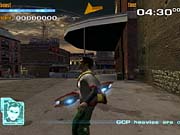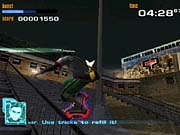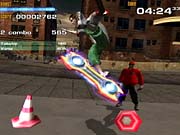Airblade
Criterion Software and Namco bring futuristic hoverboarding action to the PlayStation 2.
Airblade, Criterion Software's follow-up to its Dreamcast and PC game Trickstyle, looked like it was in danger of never making it to the States when SCEA chose not to pick it up for US release. The futuristic skateboarding game was released in Europe by SCEE earlier this year and seemed to be stuck there. Fortunately, Namco has snatched up the publishing rights to the game and will be bringing it out early next year. We spent some time with a domestic build of the game and are pleased that it will be coming to the US soon.

Airblade's story puts you in the role of Ethan Palmer. A skilled but mellow skateboarder, Ethan becomes a reluctant hero when he comes into possession of the Airblade--a prototype hoverboard designed by his friend Oscar. When Oscar is kidnapped by the GCP Corporation, which wants the Airblade, Ethan heads out to the rescue.

You'll find two main modes of play in the game, each offering several variations. The single-player mode features four variations of play: story, score, freestyle, and a training mode to familiarize you with the Airblade. The story mode offers mission-based gameplay that has you going through a level and completing tasks such as taking out enemies and grinding off vehicles before time runs out in your search for Oscar. Performing well in each level will unlock playable characters and extra levels in other modes. Score attack is a timed run through any of the levels you've unlocked. Here, you'll be able to use Ethan or any character you've unlocked. Freestyle lets you explore unlocked levels with any available character. Training will walk you through Ethan's basic moves when riding the Airblade.
Multiplayer mode offers five variations for you to play with a friend: score, trick list, ribbon tag, show off, and party mode. Score attack is a two-player split-screen version of the single-player game. Trick list challenges two players to perform a trick, combo, or action that's displayed onscreen before their opponent does. Ribbon tag is a variation on capture the flag, which has players competing to hold onto a ribbon. The catch is that the longer you have the ribbon in your possession, the more its trail will grow. Show off challenges players to outperform each other in three categories: biggest air, best combo, and grinds. Onscreen meters track your performance in each category so that you'll know which area you need to improve during the game. Finally, party mode lets up to eight players try to outscore each other in a tournament of single-player minute-long runs.
Control in the game is laid out well. You'll control Ethan with the D-pad or left analog stick. You'll jump with the X-button, and holding it down will give you a jump boost. The triangle button will grind, the circle button will grab your board and objects like poles in the level, and the square button will trigger stunts when used in conjunction with the D-pad or analog stick. The L1 and R1 triggers will spin Ethan right and left. The L2 trigger lets you slow down and stop Ethan, while the R2 trigger lets you boost your speed if you have energy stored in your boost meter. The game's trick system offers a solid number of tricks to perform. You'll be able to perform a basic trick on the ground and in the air. There will also be an extra set of tricks (air and big air tricks), which you can do in the air, depending on your positioning. Finally, you'll be able to perform grab and grind tricks as well. All the tricks can be strung together to perform combos for higher points. The game's scoring system will reduce the points you earn for a trick if you repeatedly perform the same trick in a level. And besides earning you points, performing tricks will fill your boost meter.

Airblade's graphics are extremely clean and detailed, sporting some nice lighting effects. If you remember Trickstyle, you'll experience some graphical déjà vu when you see Ethan tricking his way through a level on the Airblade. However, the game's overall look is much better than Trickstyle's, thanks to the polished graphics, solid level design, and a stable frame rate. Oscar's animation is good, and the environments offer a host of little touches to give them personality, from people on the street to graffiti on the walls of buildings.
After playing through the first few levels of the game, we're pleased that Namco has decided to pick up the game for US release. While Airblade may remind some of Trickstyle because of its trick system and some of its graphical elements, the game is a marked improvement overall. The mission-based gameplay keeps things engaging and offers you a measure of freedom when playing through a level. While an onscreen arrow points you to your next task, you can actually perform them in any order you want. The game's multiplayer modes are fun to play and maintain a playable frame rate, which is always a good thing. Airblade will ship in February 2002 for the PlayStation 2.
Got a news tip or want to contact us directly? Email news@gamespot.com
Join the conversation